6 Types of Chestnut Trees to Provide Endless Nuts
Author: Jen Worst | Editor: Omar Alonso
Review & Research: Jen Worst & Chris Miller
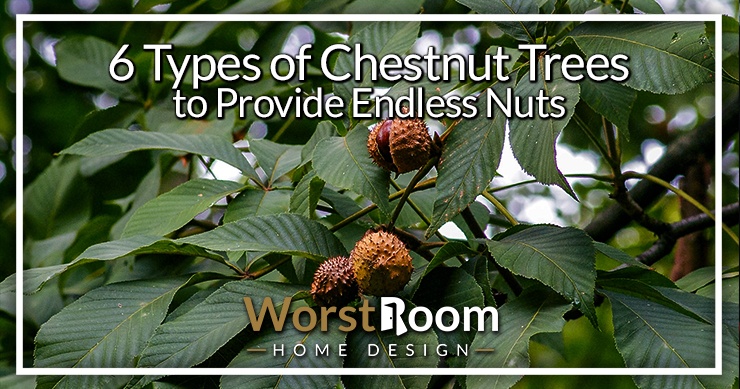
Chestnut trees are mostly self-pollinated and are highly famous in the USA. These trees look beautiful and are practically found in every forest or orchard. All the different types of chestnut trees can also fulfill wildlife and human food needs.
Chestnuts are famous, especially during the holiday season. It can also be used as a spice, and you can even peel it off and enjoy it raw. American chestnut, Japanese chestnut, European chestnut, and Chinese chestnut are some of the remarkable chestnut options you can have.
So, here in this article, our experts have thoroughly explained the types of chestnuts that would surely come in handy as both wood and fuel.
6 Types of Chestnut Trees
Many chestnut types are available, but they may contain fungus and blight, which can be dangerous for your chestnut trees and nuts. So here in this section, we'll let you know all the ins and outs of the following chestnut trees.
Here are the six most common types of trees available to us to find and grow. When you're out looking to perform some chestnut tree identification, these are the ones you should be looking out for:
- American Chestnut Tree
- Chinese Chestnut Tree
- European Chestnut Tree
- Japanese Chestnut Tree
- Dwarf Chestnut Tree
- Sweet Chestnut Tree
While there may be other rare chestnut types, they're not suitable for home growing or even finding in the wild. They'll be restricted to certain geographical locales and may not be hardy enough to find.
American Chestnut Tree
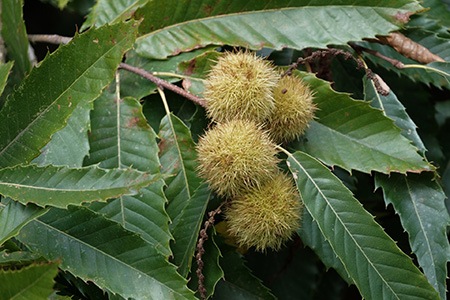
The American Chestnut is considered one of the finest chestnut trees globally and an enormous deciduous tree of the beech family native to eastern North America.
The American chestnut, also known as Castanea dentata, used to and can still reach up to 30 meters in height and 3 meters in circumference, though most now only grow around 8 meters.
This chestnut tree can also produce nuts after 6 to 7 years. The population is enormous due to its rapid growth and sizable annual seed crop compared to Oak trees.
Moreover, these types of chestnut trees can be traced down by leaf shape, petiole length, and nut size. The leaves are 14-20 cm long and 7-10 cm broad, with teeth at the edges. It even has hairy twig tips and contrasts with hairless twigs.
They are also one of the prolific bearers of nuts. The nuts start developing around late summer, with burrs opening and falling to the ground near the first frost fall. An extra point to be added is this chestnut tree requires two trees for pollination.
That's not all; the American chestnut is enriched in nitrogen, phosphorus, potassium, and magnesium from leaves than other similar trees.
These elements give the soil the right nutrients for plants to grow. Moreover, these trees are also crucial as they are a source of food for native Americans and wildlife.
Furthermore, these chestnut tree types grow faster than Oak trees, so it's easier to collect woods that are highly resistant to decay and can be used for various purposes.
European Chestnut Tree
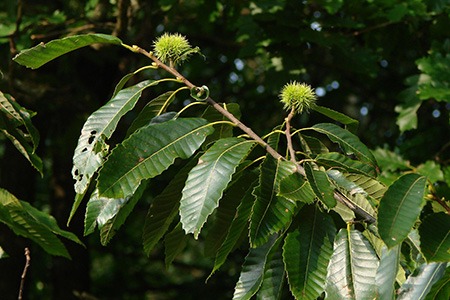
This chestnut tree is also known as Castanea Sativa. It's mainly used with spices and nuts and for wood. Also, this tree is sensitive to spring and early autumn frost that needs limestone-free and optimal soil pH of 4.5 - 6.
Furthermore, the European tree needs a mild climate and adequate moisture for a good harvest. The nut has skin shells and a shiny brown part.
These chestnut tree varieties can reach a height of 20-35 m, and the trunk is approximately 2m in diameter. The net-shape bark design with deep furrows or fissures runs spirally up the trunk. Its leaves are around 16-28 cm long and 5-9 cm broad.
These sweet chestnut trees live around 600 to 700 years or live in cultivation for up to 1000 years. However, it can even live up to 2,000 years in natural conditions.
Also, it needs heat for an extended vegetation period. Approximately 8 degrees to 15 degrees Celsius is required for optimum vegetation. Although, it can even withstand a temperature of -158 degrees Celsius without wilting or dying.
The fruit harvest is between 30 to 100kg, which may go up to 300 kg in September and mid-November. Combine these chestnuts with types of pecans and you'll have nuts forever to enjoy.
Chinese Chestnut Tree
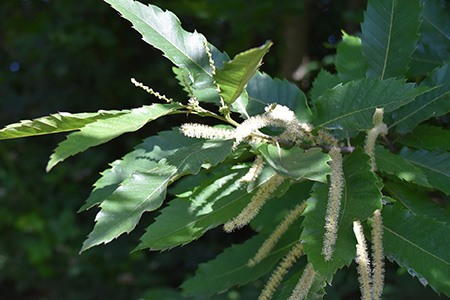
The botanical name of the Chinese types of chestnut trees is Castanea mollissima. These trees are one of the most renowned chestnut trees in America. Its nuts are often used in turkey recipes and are famous during the holiday season.
The full sun is ideal for these trees, with around six hours of direct sunlight; the Chinese chestnut tree also needs different soil than others. It requires acidic pH 5.5, moist sandy and loamy, and clay soils and also should be in orchards or groups for excellent pollination.
Chinese chestnut tree needs a hot and dry climate which is beneficial for their growth and the best time for these trees to bloom is in June.
This tree also grows in a circle shape, and it takes around 4 to 5 years to bear seeds. Their leaves are 3-5 inches in length and dark green with a toothed margin. The height of these chestnut varieties is around 40-60m.
This tree is enormous and can make dense shade in more prominent places and helps breed hybrid American types of chestnuts. Moreover, their wood is also durable and resistant to rot.
Japanese Chestnut Tree
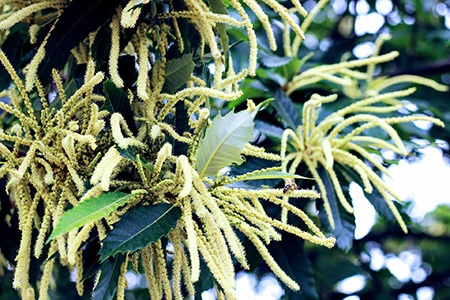
Japanese chestnuts are also known as Kuri in Japan. However, these are pretty costly. These chestnuts are pretty rich in nutrients like magnesium and copper.
The Japanese chestnuts are oval and round in shape with a layer of spines. Another shell covers the nut within the first 1 to 3 weeks with a 5 to 7 centimeters diameter.
Japanese chestnut trees can even overgrow and attain a height of up to 30 m under ideal conditions. Furthermore, this chestnut tree and its shrubs can easily grow up to 9 meters without any external needs. It also has heart-shaped leaves about 17 cm long, and you can even see these leaves turn orange during fall.
These chestnut varieties even have compound, palmate leaves with five-seven toothed leaflets attached at the same point on a central stalk and offers year-round color and beauty. The nuts, in my opinion, taste great with all types of almonds as well.
Dwarf Chestnut Tree
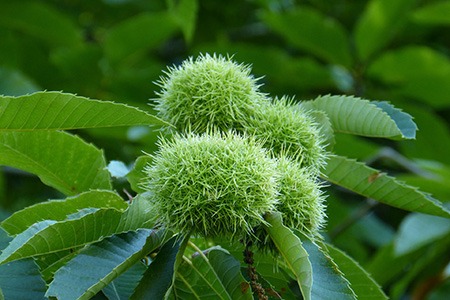
The dwarf types of chestnut trees are also known as Castanea Pumila. These Dwarf chestnuts are 30 feet tall and 10 to 20 ft wide, with tall shrubs at maturity.
The armature on these plants doesn't have any prickles and thorns, and the leaves are glossy green but turn yellow to golden brown in the fall.
The finely serrated leaves are 3-5 inches (7-12 cm) long with parallel side veins ending in short pointed teeth.
Strong smelling creamy-white flowers appear in catkins between summer and early spring. The nuts are edible and encased in burs 1.5 inches (3 cm) across.
These trees are also a food resource for humans and wildlife like chipmunks, opossum, bluejays, squirrels, and whitetail deer. You'll know if you have chipmunks because you'll be spending time learning how to fill chipmunk holes in your yard.
Once these chestnut tree types reach full maturity, they can tolerate scorching summer heat and drought. These chestnut types need dry, sandy, and loamy soil for best results.
From April to June, the yellow flower of these trees bloom. The fruit is dry but does split open when ripe. This fruit has a golden-colored capsule 2 to 3 cm in diameter with many sharp spines, mainly maturing in autumn. That's not all; the wood is hard and durable and can be used in fuel or fences.
Sweet Chestnut Tree
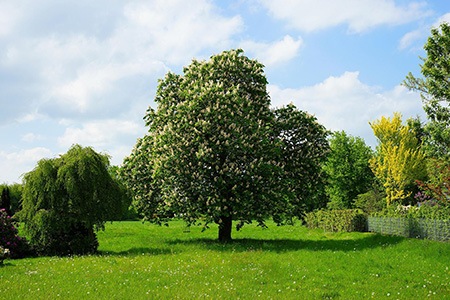
Sweet chestnuts are deciduous trees around 35m, 100 feet medium-large, and live up to 700 years. These Sweet chestnut trees belong to the same family as Oaks trees and beeches, also known as Spanish sweet chestnuts.
It has vast girths reaching up to 2m in diameter. The leaves of this chestnut tree are around 16-28 cm long and 5-9 cm broad on the edges of the leaves.
These leaves of these chestnut tree types are glossy and have 20 pairs of prominent parallel veins. In addition to this, the seed develops in the prickly green color seed cases.
Sweet chestnuts tree varieties are mainly found in southern Europe, North Africa, and Western Asian countries. These chestnut trees also require more sunlight with well-drained soil. Having said that, for optimum nut production, it also needs the coolness of winter.
So, in autumn, these types of chestnuts are sweet and an enriched source of vitamin C and B and other minerals like magnesium, potassium, and iron. The starch is high as potato and similar to wheat. They make wonderful types of garnish to enjoy on salads and ice cream treats, etc.
These sweet chestnut trees are a food resource for the red squirrels. However, other micro-moths also feed on the leaves and nuts.
Types of Chestnut Trees for Enjoyable Nuts
The fungus Cryphonectria Parasitica can cause chestnut blight, so it's better to avoid planting them altogether. You should grow them in direct sunlight and provide them with sufficient spraying water until trees are matured.
However, make sure you don't overwater them, or they will damage the chestnut trees. I hope this article will now guide you with all the necessary information regarding the different types of chestnut trees and chestnut tree identification.



